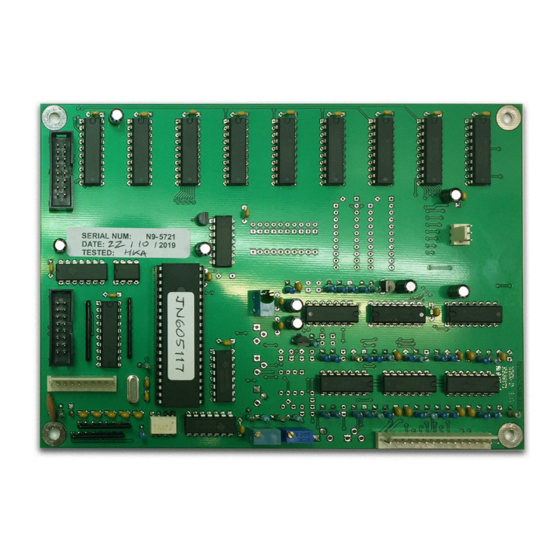
Advertisement
These instructions are only for Juno 6 MIDI retrofit kits produced after 1
N.B. Different instructions apply to earlier Kenton Juno 6 MIDI retrofit kits.
When you turn on the synthesizer for the first time, you will be in omni-off mode channel 1 for receive and also
channel 1 for transmit - See the following pages for other factory default settings. When you select a receive
channel, this will be stored in memory and will be remembered for when you subsequently turn on the synth - all
parameters listed on the next page are stored.
If you want to put the machine back to the factory default settings at any time, switch the synth on whilst holding the
red push button pressed - hold for a couple of seconds then release.
Three modes are available by pushing the red push button during normal playing mode. Before you press the red
button however, make sure that no keys are pressed on either the Juno 6 or the remote MIDI keyboard otherwise
the results may be unpredictable. The key presses can be entered on the Juno 6's own keyboard, or from the
remote MIDI keyboard.
1) PROGRAM CHANGE MODE
For sending program changes from the keyboard. Press the red push button once only (short press – then
release), any key then selects a program change which it sends through the MIDI Out. When the key is released,
you are then automatically returned to playing mode. For example a short press on the red push button followed by
bottom C will send program change #0 whereas top C will send #60. (Nothing is stored in non-volatile memory after
this operation)
2) SET-UP MODE
For setting MIDI channels and assignments. Give the red push button two short presses (half a second each) -
then release. Follow this with a key or sequence of keys as detailed on page 2. After making a MIDI channel
assignment, you will be automatically returned to playing mode but after making other assignments you will need to
press the ENTER key (Top C) to return to playing mode. This is to enable you to make the multiple key presses
required when re-assigning Sources to Destinations. (N.B. all set-ups are stored in non volatile memory).
2) TRANSPOSE MODE / ARPEGGIO CLOCK DIVIDE SETTING MODE
Press and hold the red push button for about four seconds - then release. Middle C will sound on the synth and
continue to sound until you press a key. The key that you press on the remote keyboard will be the new middle C
for MIDI IN. You can set any value up to two octaves up or down - settings outside this range will be ignored
(where middle C = no transposition) . Note that transpose mode cannot be entered from set-up mode. (N.B. the
transposition will be stored in non volatile memory).
The bottom four octaves on a 61 note remote keyboard are used to set "transpose" but the top octave will set the
arpeggio divide.
G
= Set triplet on (can be used with any of below)
Ab = Clock divided by 8 (eighth speed)
A
= Clock divided by 4 (quarter speed)
For more information on the operation of the arpeggio clock with MIDI, see note #11 further on.
User instructions for Kenton MIDI retrofit for
ROLAND JUNO 6
Firmware JN605100 or later
USING THE MIDI INTERFACE
RED PUSH BUTTON
Bb = Clock divided by 2 (half speed)
B
= Clock normal - no divide (full speed)
TOP C
= Enter - return to normal playing & store new setting
st
March 2006
Advertisement
Table of Contents

Summary of Contents for Kenton ROLAND JUNO 6
- Page 1 March 2006 Firmware JN605100 or later N.B. Different instructions apply to earlier Kenton Juno 6 MIDI retrofit kits. USING THE MIDI INTERFACE When you turn on the synthesizer for the first time, you will be in omni-off mode channel 1 for receive and also channel 1 for transmit - See the following pages for other factory default settings.
- Page 2 Function of keys during set-up mode: Receive channel 1 (default) [ Bottom C - MIDI note #36 ] " " " " " " " " " " " " " " " " " " " " " " "...
- Page 3 ASSIGNING MIDI CONTROL SOURCES TO DESTINATIONS SOURCE DEFAULT DESTINATION Pitch-bend wheel Pitch-bend Modulation wheel (cc#1) Modulation Aftertouch Modulation Velocity ---- Controller X (def cc#16) VCF / Filter cutoff Controller Y (def cc#17) MIDI Volume (cc#7) VCA / Volume 1) To assign sources to destinations, a) press the red push button twice to enter set-up mode b) select a source by using one of the keys A to Eb (see table on previous page) c) [optionally if the source is Controller X or Y, you can assign a controller to it now –...
- Page 4 All Kenton MIDI Kits come with a 12 month (from purchase date) back to base warranty, (i.e. customer must arrange and pay for carriage to and from Kenton Electronics). Note that kits should be fitted as soon as possible after purchase, as the retrofit kits are in a continuous state of development.





Need help?
Do you have a question about the ROLAND JUNO 6 and is the answer not in the manual?
Questions and answers